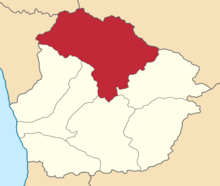Lechkhumi uezd
Lechkhumi uezd
Лечхумскій уѣздъ | |
|---|---|
 Location in the Kutais Governorate | |
| Country | Russian Empire |
| Viceroyalty | Caucasus |
| Governorate | Kutaisi |
| Established | 1867 |
| Abolished | 1930 |
| Capital | Tsageri |
| Area | |
| • Total | 4,873.05 km2 (1,881.50 sq mi) |
| Population (1916) | |
| • Total | 61,914 |
| • Density | 13/km2 (33/sq mi) |
| • Rural | 100.00% |
The Lechkhumi uezd[a] was a county (uezd) of the Kutaisi Governorate of the Caucasus Viceroyalty of the Russian Empire. It bordered the Terek and Kuban oblasts to the north, the Sukhumi Okrug to the west, the Zugdidi, Senaki, and Kutais uezds to the south and the Racha uezd to the east. The area of the uezd corresponded to most of the contemporary Samegrelo-Zemo Svaneti region of Georgia. The administrative center of the Lechkhumi uezd was the town of Tsageri.[1]
History
The Lechkhumi uezd was formed in 1867 as part of the Kutaisi Governorate on the territory during the time of the Russian Empire. In 1918, the Kutaisi Governorate including the Lechkhumi uezd was incorporated into the Democratic Republic of Georgia.[1]
Administrative divisions
The subcounties (uchastoks) of the Lechkhumi uezd were:[2]
| Uchastok | Russian name | 1912 population | Area |
|---|---|---|---|
| Alpanskiy | Алпанскій участокъ | 22,791 | 449.41 square versts (511.46 km2; 197.47 sq mi) |
| Svaneti | Сванетскій участокъ | 12,184 | 2,383.37 square versts (2,712.42 km2; 1,047.27 sq mi) |
| Tsageri | Цагерскій участокъ | 23,264 | 1,449.10 square versts (1,649.17 km2; 636.75 sq mi) |
Demographics
Russian Empire census (1897)
According to the Russian Empire census of 1897, the Lechkhumi uezd had a population of 47,779, including 23,522 men and 24,257 women. The majority of the population indicated Imeretian to be their mother tongue, with a significant Svan speaking minority.[3]
| Language | Native speakers | % |
|---|---|---|
| Imeretian | 31,520 | 65.97 |
| Svan | 15,359 | 32.15 |
| Jewish | 441 | 0.92 |
| Georgian | 226 | 0.47 |
| Armenian | 91 | 0.19 |
| Mingrelian | 60 | 0.13 |
| Russian | 26 | 0.05 |
| Ossetian | 9 | 0.02 |
| Kurdish | 6 | 0.01 |
| Avar-Andean | 4 | 0.01 |
| Tatar[b] | 4 | 0.01 |
| Ukrainian | 2 | 0.00 |
| Persian | 2 | 0.00 |
| Other | 29 | 0.06 |
| TOTAL | 47,779 | 100.00 |
Caucasian Calendar (1917)
According to the 1917 publication of the Caucasian Calendar, the Lechkhumi uezd had 61,914 residents in 1916, including 32,691 men and 29,223 women, 60,945 of whom were the permanent population, and 969 were temporary residents:[4]
| Nationality | Number | % |
|---|---|---|
| Georgians | 60,407 | 97.57 |
| Jews | 1,372 | 2.22 |
| Armenians | 96 | 0.16 |
| Other Europeans | 25 | 0.04 |
| Russians[c] | 14 | 0.02 |
| TOTAL | 61,914 | 100.00 |
Notes
- ^
- ^ Later known as Azerbaijani.
- ^ The Caucasian Calendar did not distinguish between Russians, Ukrainians, and Belarusians.
References
- ^ a b Tsutsiev, Arthur (2014). Atlas of the Ethno-Political History of the Caucasus. Translated by Nora Seligman Favorov. New Haven: Yale University Press. ISBN 9780300153088.
- ^ Кавказский календарь на 1913 год [Caucasian calendar for 1913] (in Russian) (68th ed.). Tiflis: Tipografiya kantselyarii Ye.I.V. na Kavkaze, kazenny dom. 1913. pp. 160–167. Archived from the original on 19 April 2022.
- ^ a b "Демоскоп Weekly - Приложение. Справочник статистических показателей". www.demoscope.ru. Retrieved 2022-06-27.
- ^ Кавказский календарь на 1917 год [Caucasian calendar for 1917] (in Russian) (72nd ed.). Tiflis: Tipografiya kantselyarii Ye.I.V. na Kavkaze, kazenny dom. 1917. pp. 198–205. Archived from the original on 4 November 2021.

